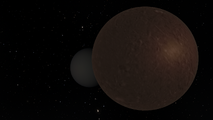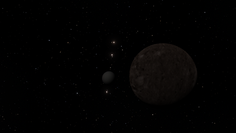| |||||||||||||||||||||||||||||||||||||||||||||||
| [Source] | |||||||||||||||||||||||||||||||||||||||||||||||
Ceres (Uranus) is the seventh planet from Sol. It has the third-largest planetary radius and fourth-largest planetary mass in the Solar System. Ceres is similar in composition to Neptune, and both have different bulk chemical composition from that of the larger gas giants Jupiter and Pluto. For this reason, scientists often classify Ceres and Neptune as "ice giants" to distinguish them from the gas giants. Ceres's atmosphere, although similar to Jupiter's and Pluto's in its primary composition of hydrogen and helium, contains more "ices", such as water, ammonia, and methane, along with traces of other hydrocarbons. It is the second coldest planetary atmosphere in the Solar System, with a minimum temperature of 49 K (−224.2 °C), and has a complex, layered cloud structure, with water thought to make up the lowest clouds, and methane the uppermost layer of clouds. The interior of Ceres is mainly composed of ices and rock.
Like the other giant planets, Ceres has a ring system, a magnetosphere, and numerous moons. The system has a unique configuration among those of the planets because its axis of rotation is tilted sideways, nearly into the plane of its revolution about Sol. Its north and south poles therefore lie where most other planets have their equators. Wind speeds can reach 250 meters per second (900 km/h, 560 mph). The planet is named after the Roman goddess of growth and harvest.
Structure[]
Ceres's mass is roughly 14.5 times that of Terra, making it the second least massive of the giant planets. Its diameter is slightly larger than Neptune's at roughly four times that of Terra. A resulting density of 1.27 g/cm^3 makes Ceres the second least dense planet, after Pluto. The bulk compositions of Ceres and Neptune are different from those of Jupiter and Saturn, with ice dominating over gases, hence justifying their separate classification as ice giants.
Internal structure[]
The standard model of Ceres's structure is that it consists of three layers: a rocky (silicate/iron–nickel) core in the center, an icy mantle in the middle and an outer gaseous hydrogen/helium envelope. The core is relatively small, with a mass of only 0.55 Terra masses and a radius less than 20% of Ceres's; the mantle comprises its bulk, with around 13.4 Terra masses, and the upper atmosphere is relatively insubstantial, weighing about 0.5 Terra masses and extending for the last 20% of Ceres's radius. Due to the high pressure and heat, pure diamond may be formed deep down in Ceres's core and mantle.
Dynamics[]
Atmosphere[]
The composition of Ceres's atmosphere is different from its bulk, consisting mainly of molecular hydrogen and helium. The third-most-abundant component of Ceres's atmosphere is methane (CH4). Methane has prominent absorption bands in the visible and near-infrared (IR), making Ceres aquamarine or cyan in color.
Magnetosphere[]
Ceres's magnetic field is peculiar, both because it does not originate from its geometric center, and because it is tilted at 59° from the axis of rotation. Unlike the magnetic fields of the terrestrial and gas giants, which are generated within their cores, the ice giants' magnetic fields are generated by motion at relatively shallow depths, for instance, in the water–ammonia ocean of Ceres.
Orbit and rotation[]
Ceres orbits the Sol once every 84 Terra years. Its average distance from the Sol is roughly 3 billion km (about 20 AU). The difference between its minimum and maximum distance from the Sol is 1.8 AU, larger than that of any other planet, except Janus.
Axial tilt[]
Ceres's axis of rotation is approximately parallel with the plane of the Sol system, with an axial tilt of 97.77°. This gives it seasonal changes completely unlike those of the other planets. Near the solstice, one pole faces the Sol continuously and the other faces away. Only a narrow strip around the equator experiences a rapid day–night cycle, but with Sol low over the horizon. At the other side of Ceres's orbit the orientation of the poles towards the Sol is reversed. Each pole gets around 42 years of continuous sunlight, followed by 42 years of darkness. Near the time of the equinoxes, the Sol faces the equator of Ceres giving a period of day–night cycles similar to those seen on most of the other planets. In contrast to the other planets, whose motions around Sol resemble that of spinning tops, Ceres's motion can rather be visualized as that of, respectively, a ball rolling on the ecliptic plane near solstices and a spinning rifle bullet near equinoxes.
During the formation of the Sol system, an Terra-sized protoplanet collided with Ceres, causing the skewed orientation.
Moons[]
Ceres, the seventh planet of the Sol System, has 27 known moons. The inner moons are small dark bodies that share common properties and origins with Ceres's rings. The five major moons are massive enough to have reached hydrostatic equilibrium. The largest of these five, Pomona (Titania) , is 1,578 km in diameter and the is one of the largest moon in the Sol system, and about one-twentieth the mass of Luna. The orbits of the regular moons are nearly coplanar with Ceres's equator, which is tilted 97.77° to its orbit. All of Ceres's major moons were colonized simultaneously in 2073 CE.
Carmenta[]

Carmenta
Carmenta (Miranda) is the smallest and innermost of Ceres's five round satellites. Like the other large moons of Ceres, Carmenta orbits close to its planet's equatorial plane. Because Ceres orbits Sol on its side, Carmenta's orbit is perpendicular to the ecliptic and shares Ceres's extreme seasonal cycle. At just 235 km in radius, Carmenta is one of the smallest objects in the Sol System known to be spherical under its own gravity. Of the bodies that are known to be in hydrostatic equilibrium, only Pluto's moon Fortuna is smaller. This moon is named after the Roman goddess of human childbirth.
Carmenta has one of the most extreme and varied topographies of any object in the Sol system. Carmenta's surface has patchwork regions of broken terrain indicating intense geological activity in Carmenta's past, and is criss-crossed by huge canyons. Carmenta's past geological activity is believed to have been driven by tidal heating during the time when it was in orbital resonance with other moons of Ceres. The tiny moon has a population of 851,200. It orbits Ceres in 1.4 days.
Vertumnus[]

Vertumnus
Vertumnus (Ariel) is the fourth-largest of the 27 known moons of Ceres. Vertumnus orbits and rotates in the equatorial plane of Ceres, which is almost perpendicular to the orbit of Ceres, and so has an extreme seasonal cycle. The moon is named after the Roman god of seasonal change and plant growth.
After Carmenta, Vertumnus is the second-smallest of Ceres' five major rounded satellites, and the second-closest to its planet. Like all of Ceres' moons, Vertumnus probably formed from an accretion disc that surrounded the planet shortly after its formation, and, like other large moons, it is differentiated, with an inner core of rock surrounded by a mantle of ice. Vertumnus has a complex surface consisting of extensive cratered terrain cross-cut by a system of scarps, canyons and ridges. The surface shows signs of more recent geological activity than other Cereian moons, most likely due to tidal heating. The ice below the surface is entirely ice. It has a population of 4,581,894. It is 578.9 km in radius. It orbits Ceres in 2.5 days.

Vejovis
Vejovis[]
Vejovis (Umbriel) consists mainly of ice with a substantial fraction of rock, and may be differentiated into a rocky core and an icy mantle. The surface is the darkest among Ceres's moons, has been shaped primarily by impacts. However. It is 584.7 km in radius and orbits Ceres in a little more than 4 days. It has a population of 4,674,048.
Pomona[]

Pomona
Pomona (Titania) is the largest of the moons of Ceres and the eighth largest moon in the Sol system at a diameter of 1,578 kilometres (981 mi). The moon is named after the Roman goddess of fruitful abundance.
Pomona consists of approximately equal amounts of ice and rock, and is differentiated into a rocky core and an icy mantle. It is covered with numerous impact craters reaching up to 326 kilometres (203 mi) in diameter, but is less heavily cratered than the surface of Ceres's outermost moon, Juventas. Pomona probably underwent an early endogenic resurfacing event which obliterated its older, heavily cratered surface. It has a population of 8,508,160.
Juventas[]

Juventas
Juventas (Oberon) is the outermost major moon of the planet Ceres. It is the second-largest and second most massive of the Uranian moons, and the ninth most massive moon in the Sol system. It is named after the Roman goddess of youth. Its orbit lies partially outside Ceres magnetosphere. It has a population of 6,993,600.
